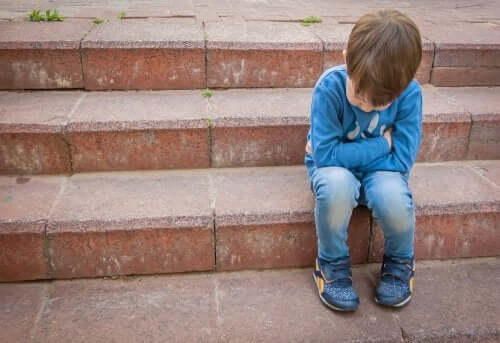The Characteristics of School Bullies

Students who participate in aggressive and violent behaviors against others tend to possess a specific physical and psychological profile. Below, we’ll go into detail about the most common characteristics of school bullies.
It’s important for teachers and professors to be aware of these characteristics. Educators have a responsibility when it comes to identifying possible aggressors by observing and recording student behavior. This way, they can anticipate, prevent, and reduce cases of bullying in their schools.
“Youth who bully others are at increased risk for substance use, academic problems, and experiencing violence later in adolescence and adulthood. Youth who bully others and are bullied themselves suffer the most serious consequences and are at greater risk for mental health and behavioral problems.”
Center for Disease Control, 2017
The most common characteristics of school bullies
The objective of school bullies is to constantly submit their victims. They take advantage of a variety of situations, including physical, social, or psychological advantages over those they bully.
Bullies may practice intimidation behaviors individually or in groups. These acts of bullying can take on a number of forms… From physical violence to more subtle behaviors, which are emotional, verbal, and psychological.

But what type of students commit these acts of aggression? In general, school bullies have the following characteristics in common:
- Bullies are physically stronger than their peers.
- Are dominant and impulsive.
- Refuse to follow established rules and codes of conduct.
- Have low tolerance when it comes to frustration.
- They tend to challenge authority.
- They possess seemingly high self-esteem.
- Demonstrate a positive attitude towards violence.
- Show a lack of empathy towards their victims.
- They seem to lack feelings of guilt.
- Have problematic social and family relationships.
The different types of bullies
Despite these being the most common characteristics of school bullies, we need to take into account that there is more than one type of bully. According to Alexander Schwarz, there are three different types, which are the following:
- Aggressive. This is the most common type of bully. They act out of a desire for power and dominance over others. They reinforce their personalities by bullying one of their classmates.
- Passive. These students are insecure. They aren’t the ones who initiate the intimidation. Rather, they wait until the time when aggression begins, and then they become eager participants. In fact, they tend to show loyalty to an aggressive bully.
- Bully-victims. These aggressors have, at some time in the past or present, been victims of bullying. These students aren’t very popular and they intimidate or have intimidated others who are weaker than them. At the same time, they are or have been bullied by classmates that are stronger than them.

The consequences of assuming the role of aggressor
- Establish toxic and negative social relationships.
- Perform poorly in school or fail completely.
- Display cruelty and emotional instability.
- Use aggression as a way to resolve their conflicts and problems.
- Have no ability to self-criticize.
- Respect aggressive behavior.
- Internalize delinquent and antisocial behaviors.
- Display a lack of sensitivity in the face of the suffering of others.
- Loss of empathy towards others.
As these children approach adulthood, they fall into social maladjusted behaviors. These may include vandalism, alcohol abuse, and the abuse of other substances. At the same time, they’re likely to mistreat others in the future (their partner, their children, etc.) or become aggressive delinquents.
Therefore, it’s important to detect and prevent bullying. To do this, schools must carry out activities that promote and develop among students abilities such as empathy, sensitivity, and respect in regards to diversity and the needs, characteristics, and interests of others.
Students who participate in aggressive and violent behaviors against others tend to possess a specific physical and psychological profile. Below, we’ll go into detail about the most common characteristics of school bullies.
It’s important for teachers and professors to be aware of these characteristics. Educators have a responsibility when it comes to identifying possible aggressors by observing and recording student behavior. This way, they can anticipate, prevent, and reduce cases of bullying in their schools.
“Youth who bully others are at increased risk for substance use, academic problems, and experiencing violence later in adolescence and adulthood. Youth who bully others and are bullied themselves suffer the most serious consequences and are at greater risk for mental health and behavioral problems.”
Center for Disease Control, 2017
The most common characteristics of school bullies
The objective of school bullies is to constantly submit their victims. They take advantage of a variety of situations, including physical, social, or psychological advantages over those they bully.
Bullies may practice intimidation behaviors individually or in groups. These acts of bullying can take on a number of forms… From physical violence to more subtle behaviors, which are emotional, verbal, and psychological.

But what type of students commit these acts of aggression? In general, school bullies have the following characteristics in common:
- Bullies are physically stronger than their peers.
- Are dominant and impulsive.
- Refuse to follow established rules and codes of conduct.
- Have low tolerance when it comes to frustration.
- They tend to challenge authority.
- They possess seemingly high self-esteem.
- Demonstrate a positive attitude towards violence.
- Show a lack of empathy towards their victims.
- They seem to lack feelings of guilt.
- Have problematic social and family relationships.
The different types of bullies
Despite these being the most common characteristics of school bullies, we need to take into account that there is more than one type of bully. According to Alexander Schwarz, there are three different types, which are the following:
- Aggressive. This is the most common type of bully. They act out of a desire for power and dominance over others. They reinforce their personalities by bullying one of their classmates.
- Passive. These students are insecure. They aren’t the ones who initiate the intimidation. Rather, they wait until the time when aggression begins, and then they become eager participants. In fact, they tend to show loyalty to an aggressive bully.
- Bully-victims. These aggressors have, at some time in the past or present, been victims of bullying. These students aren’t very popular and they intimidate or have intimidated others who are weaker than them. At the same time, they are or have been bullied by classmates that are stronger than them.

The consequences of assuming the role of aggressor
- Establish toxic and negative social relationships.
- Perform poorly in school or fail completely.
- Display cruelty and emotional instability.
- Use aggression as a way to resolve their conflicts and problems.
- Have no ability to self-criticize.
- Respect aggressive behavior.
- Internalize delinquent and antisocial behaviors.
- Display a lack of sensitivity in the face of the suffering of others.
- Loss of empathy towards others.
As these children approach adulthood, they fall into social maladjusted behaviors. These may include vandalism, alcohol abuse, and the abuse of other substances. At the same time, they’re likely to mistreat others in the future (their partner, their children, etc.) or become aggressive delinquents.
Therefore, it’s important to detect and prevent bullying. To do this, schools must carry out activities that promote and develop among students abilities such as empathy, sensitivity, and respect in regards to diversity and the needs, characteristics, and interests of others.
All cited sources were thoroughly reviewed by our team to ensure their quality, reliability, currency, and validity. The bibliography of this article was considered reliable and of academic or scientific accuracy.
- Garaigordobil, M. (2011). El maltrato entre iguales: definición, prevalencia, consecuencias, identificación e intervención. San Sebastián: Universidad del País Vasco.
- Schwarz, A. (2013). El libro del bullying. Madrid: Alianza.
- Trautmann, A. (2008). Maltrato entre pares o” bullying”: Una visión actual. Revista chilena de pediatría, 79(1), 13-20.
This text is provided for informational purposes only and does not replace consultation with a professional. If in doubt, consult your specialist.








